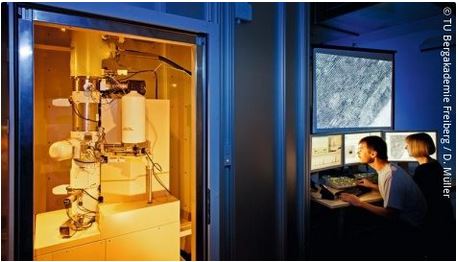Using analytical high-resolution transmission electron microscopy, a team at TU Bergakademie Freiberg investigated how the magnetic properties of the nanoparticles can further be improved via microstructure design.
The knowledge of the exact structure of the iron oxide nanoparticles having a size between 20 and 30 nanometers helps to optimize the manufacturing process and to improve the magnetic properties of the particles systematically. Each particle consists of at least two superparamagnetic nanocrystalline cores and a shell that does not contribute to the magnetic properties. The maximum magnetization of the nanoparticles depends on the mutual orientation of the individual cores.
"The current state of research assumed that a strong alignment of magnetic moments in multi-core iron oxide nanoparticles is enabled by the same crystallographic orientation of individual cores. However, our analyses showed that this is not necessarily true," says Stefan Neumann, research associate at TU Bergakademie Freiberg and the first author of the publication. "Also other, but still specific crystallographic orientation relationships of the cores can promote their magnetic interaction. Nevertheless, a fully random alignment of the cores deteriorates the magnetic properties of the nanoparticles," Stefan Neumann explains further.
"In order to be able to produce highly superparamagnetic iron oxide nanoparticles for future applications in medicine on demand, we need knowledge of their internal structure," says co-author Prof. David Rafaja, head of the Institute of Materials Science at TU Bergakademie Freiberg. "During the production of the nanoparticles, individual cores are formed first. When the cores get more time to align in the right way, then the magnetic properties of the nanoparticles can further be improved."
The results were obtained within the priority program "MehrDimPart - Highly Specific and Multidimensional Fractionation of Fine Particle Systems with Technical Relevance" funded by the Deutsche Forschungsgemeinschaft DFG. The aim of the research is to develop technological approaches that enable a controlled production of highly specific and technologically relevant particle systems with desired properties.
In addition to the team from TU Bergakademie Freiberg, scientists from the Karlsruhe Institute of Technology have also contributed to the current publication. The basic research behind this work was focussed on the structure of the nanoparticles to be able to optimize the production of particles with specific magnetic properties. A toxicological study was not carried out.
Source: Technische Universität Bergakademie Freiberg



![[Translate to Englisch:] Cluster Nanotechnologie [Translate to Englisch:] Cluster Nanotechnologie](/fileadmin/_processed_/d/8/csm_logo_cluster_nanotec_farbe_8a0c7f0f23.png)

![[Translate to Englisch:] Netzwerk NanoCarbon [Translate to Englisch:] Netzwerk NanoCarbon](/fileadmin/_processed_/c/b/csm_logo_nanocarbon_farbe_9ca30725ab.png)
![[Translate to Englisch:] Netzwerk nanoInk [Translate to Englisch:] Netzwerk nanoInk](/fileadmin/_processed_/d/b/csm_logo_nanoink_farbe_304816a988.png)
![[Translate to Englisch:] Netzwerk NanoAnalytik [Translate to Englisch:] Netzwerk NanoAnalytik](/fileadmin/_processed_/2/2/csm_logo_nanoanalytik_farbe_d05f251de0.png)
![[Translate to Englisch:] Netzwerk NanoSilber [Translate to Englisch:] Netzwerk NanoSilber](/fileadmin/_processed_/7/4/csm_logo_nanosilber_farbe_2fb968cc0d.png)
![[Translate to Englisch:] Netzwerk Nano4eMob [Translate to Englisch:] Netzwerk Nano4eMob](/fileadmin/_processed_/5/6/csm_logo_Nano4emob_farbe_53023146a7.jpg)
![[Translate to Englisch:] Netzwerk NanoGeoTherm [Translate to Englisch:] Netzwerk NanoGeoTherm](/fileadmin/_processed_/e/8/csm_logo_NanoGeoTherm_farbe_0bbcee1253.png)

![[Translate to Englisch:] Innovationsforum Carbon.Nano goes Macro [Translate to Englisch:] Innovationsforum Carbon.Nano goes Macro](/fileadmin/_processed_/b/f/csm_logo_hybride-materialien_farbe_692e4138e7.png)
